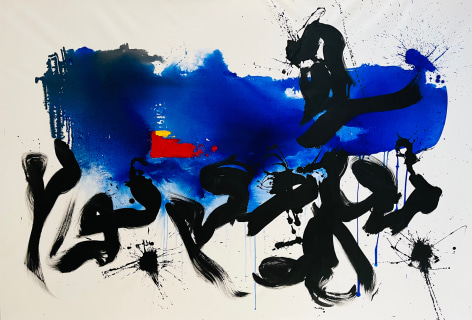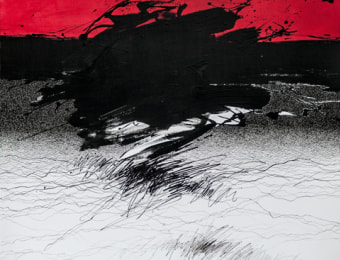
Golnaz Fathi (b. 1972) is part of a thriving generation of Iranian artists who grew up during the Islamic revolution and the Iran-Iraq war, a deeply isolated period of the country’s history. Fathi, whose work is in the collections of The Metropolitan Museum of Art and The British Museum, is one of the few women in Iran to excel at traditional calligraphy. Fascinated by the expressive nature of calligraphic forms, she spent years rigorously training up to eight hours daily, learning to control her breathing and writing poetry with a qalam to master traditional strokes.
Fathi has a Bachelor of Arts degree in graphic design from Azad University, Tehran, and a diploma in Iranian calligraphy from the Iranian Society of Calligraphy. After becoming one of the country’s most skilled practitioners, Fathi left the privileged world of traditional calligraphy to pursue a career as a contemporary artist. Over time, she has developed a distinctive visual language derived from her reinterpretations of Persian calligraphy. It is gestural, abstract and layered with meaning. Fathi is widely recognized for expanding the tradition of calligraphy and pushing it to new heights. Her works are inspired by American Abstract Expressionists and Iranian and Middle Eastern modernists who pioneered the use of the written word as a pictorial element in the late 1950s and early 1960s. Technically brilliant, she has developed a new visual language, which reconciles the ancient with the contemporary.
Early works were often in fine pen, mostly on varnished raw, rectangular, polyptych canvases, in a limited palette of white, black, red and yellow. Fathi layered canvases with thousands of minute marks echoing the curvilinear forms of calligraphic letters and words. These intricate lines coalesce into minimalist compositions that can be read in multiple ways—as landscapes, electronic transmissions or atmospheric phenomena. She often refrained from titling these works, allowing viewers free reign to assign their own interpretations.
More recent works, although in her familiar limited palette, are freer and more boldly expressive. Fathi does not plot colors in advance nor does she create preliminary sketches. Instead, she immerses herself in the moment, tapping into the kind of creativity that arises from unconstrained movement, free of forethought or expectation. These are action paintings. She sets the canvases on the floor, spontaneously dripping and spilling paint across the surface, allowing chance to determine the forms. Syncing her movements to the rhythm of the music that always fills her studio, Fathi immerses herself in the pure physicality of the process.
Fathi’s works are in the permanent collections of The Metropolitan Museum of Art, New York, which in 2019 featured her work in the exhibition The Decorated Word: Writing and Picturing in Islamic Calligraphy; The British Museum, London; Denver Art Museum, Colorado; Asian Civilisations Museum, Singapore; Islamic Arts Museum Malaysia, Kuala Lumpur; Museum of Contemporary Art, CAA, Hangzhou, China; World Bank, Washington, D.C.; Brighton & Hove Museums, England; Carnegie Mellon University, Doha; Devi Art Foundation, New Delhi; The Farjam Collection, Dubai. In 2015, her work was exhibited in Frontiers Reimagined at the 56th Venice Biennale.
Golnaz Fathi has been recognized with numerous awards and accolades. In 1995, she was named Best Woman Calligraphist by the Iranian Society of Calligraphy. In 2010, she was invited to be a member of the selection committee of the renowned Sharjah Calligraphy Biennial and in the following year was chosen as a Young Global Leader Honoree by the World Economic Forum.

















